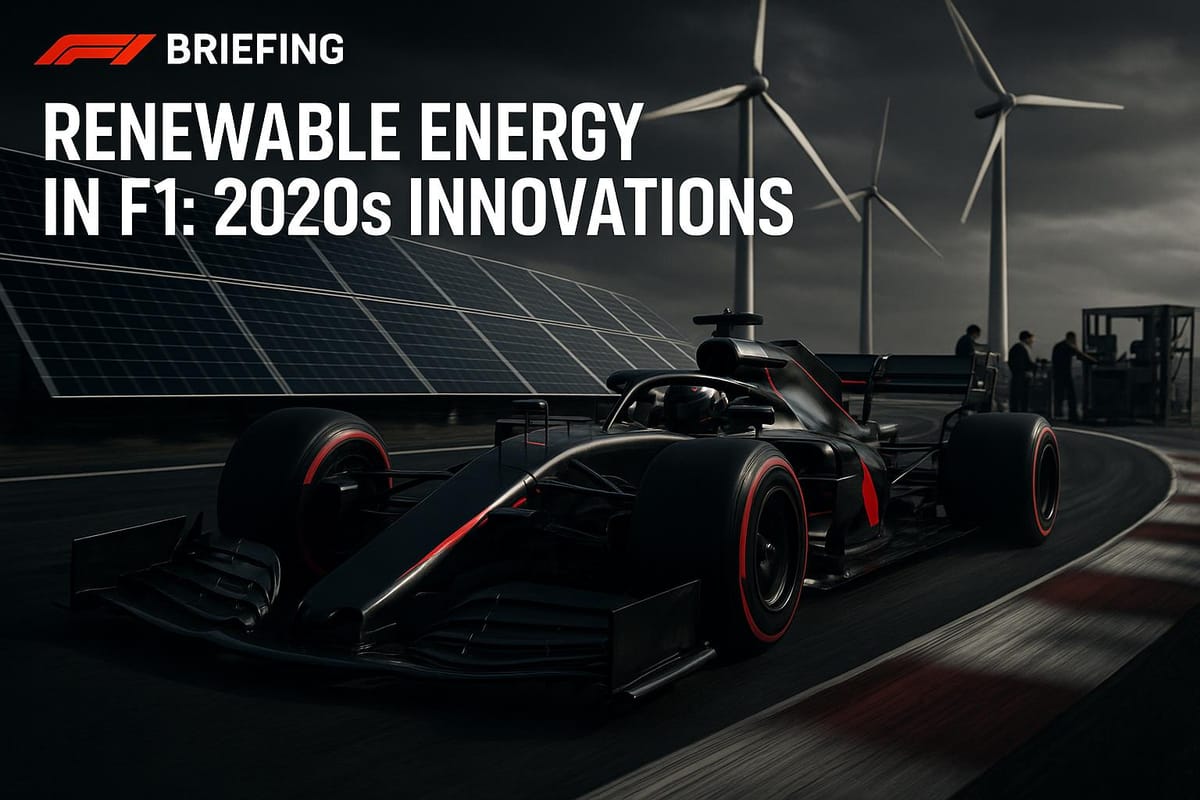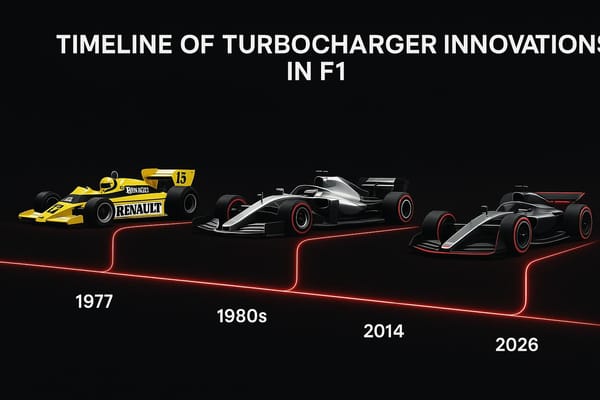Renewable Energy in F1: 2020s Innovations
Explore how Formula One is innovating with renewable energy, from synthetic fuels to sustainable race circuits, paving the way for a greener motorsport future.

Formula One has transformed in the 2020s, focusing on reducing its carbon footprint while maintaining high performance. Here's how F1 has integrated renewable energy into its ecosystem:
- Cleaner Facilities: Teams now use solar power, renewable electricity, and energy-efficient upgrades, cutting emissions by 59% compared to 2018.
- Sustainable Fuels: Synthetic fuels, made from renewable energy and captured CO2, are being developed to replace traditional options.
- Hydrogen and Batteries: Hydrogen fuel cells and large-scale battery systems are being tested for energy storage and auxiliary power.
- Race Circuits: Many circuits now use solar panels, wind turbines, and battery storage to power events, reducing reliance on traditional grid electricity.
- Logistics: Optimized transport routes and consolidated shipping have reduced emissions from moving teams and equipment.
Despite challenges like high costs and infrastructure upgrades, F1's push toward renewable energy has led to lower emissions, cost savings, and operational improvements. The upcoming 2026 regulations will further accelerate the use of cleaner fuels and energy systems, setting the stage for a greener future in motorsport.
Clean Energy in F1 Facilities and Circuits
Team Factories Go Green
F1 teams are making real strides in reducing their carbon footprint by transitioning their factories to renewable energy sources. These facilities now rely on renewable electricity, on-site solar power, and energy efficiency upgrades, leading to a significant drop in emissions compared to 2018 levels.
"Emissions from Factories and Facilities have reduced by over 34,000 tCO2e compared to 2018, representing a 59% reduction in this area. This has been achieved through the continued transition to renewable energy sources to power Formula 1 and F1 Teams sites."
This progress highlights how renewable energy adoption is transforming team operations. Many team headquarters now have on-site solar systems generating clean power, while efficiency improvements help cut overall energy consumption. These upgrades are the cornerstone of F1's broader push toward clean energy across its entire ecosystem.
Key Renewable Energy Technologies in F1
Synthetic Fuels and E-Fuels
In its drive toward carbon neutrality, F1 is focusing on synthetic fuels, also known as e-fuels, as a promising alternative to traditional fossil fuels. These fuels are created using renewable energy and captured carbon dioxide, with processes like Fischer-Tropsch synthesis converting renewable hydrogen and CO2 into usable fuel. While current regulations mandate specific fuel blends, there’s growing momentum to transition fully to fuels derived from sustainable sources. This change could reshape F1’s fuel strategy and even influence industries that are challenging to electrify. As this fuel evolution progresses, it naturally brings attention to other energy storage and generation technologies.
Hydrogen and Battery Systems
While F1 cars currently rely on hybrid power units, hydrogen fuel cells are being explored as a cleaner way to power essential support equipment during race weekends. These cells provide an eco-friendly solution for generating electricity on-site. Additionally, teams are delving into large-scale battery storage systems to handle peak energy demands, reinforcing F1's commitment to efficient energy recovery. These innovations, both on and off the track, are often driven by strategic collaborations that push the boundaries of clean energy technologies.
Clean Energy Partnerships
To align with its sustainability goals, F1 teams and governing bodies are teaming up with renewable energy companies to integrate clean power solutions like solar and wind energy into their operations. These partnerships extend to team facilities and race circuits, ensuring a broader adoption of renewable technologies. Joint research initiatives are also focusing on advancing battery technologies and sustainable practices. Through these collaborations, F1 is actively reducing its environmental footprint while improving operational efficiency across the board.
Results: Costs, Performance, and Carbon Reduction
Carbon Emission Cuts
F1's push toward renewable energy is starting to show real results, with noticeable reductions in carbon emissions across key areas like facility operations, transportation, and race circuit energy use.
At team facilities, CO₂ emissions have dropped significantly thanks to renewable energy adoption, improved manufacturing processes, and smarter wind tunnel operations. Race circuits are also stepping up, integrating renewable energy systems that power weekend events with less reliance on traditional energy sources. Where diesel generators and grid electricity once dominated, clean energy solutions now take the lead. Many circuits now use battery storage systems to store renewable energy and redistribute it during peak demand, cutting the need for carbon-heavy backup power.
Transportation and logistics have also seen improvements. By optimizing shipping routes and consolidating equipment transport, the sport has reduced the emissions tied to moving teams and gear between race locations. These combined efforts are helping F1 make meaningful progress in shrinking its carbon footprint - and they’re paying off in other ways too.
Financial and Operational Benefits
The shift to renewable energy isn’t just about cutting emissions - it’s also saving money and improving operations. As renewable technologies have become more affordable, teams are enjoying more predictable energy costs.
Long-term renewable energy contracts have protected teams from the ups and downs of fossil fuel prices, with many reporting lower energy bills as a result. Battery storage systems have also proven their worth, reducing downtime during critical operations like wind tunnel testing and manufacturing. On top of that, smart energy management systems are helping teams fine-tune their energy use, driving down overall costs.
Race circuits are experiencing similar benefits. By reducing their reliance on costly temporary power solutions during race weekends, circuits are cutting expenses. Permanent renewable energy setups have even created opportunities to sell excess energy back to local grids when races aren’t happening, adding a new revenue stream.
Implementation Challenges
While the benefits are clear, the road to full renewable energy adoption isn’t without hurdles. High upfront costs, aging infrastructure, and the technical complexity of integration are slowing progress.
Older team facilities and race circuits often require major upgrades to support solar panels, battery storage, and smart grid connections. Retrofitting these spaces can be both disruptive and expensive, demanding significant engineering work and temporary shutdowns.
Adding to the challenge, F1’s high-precision operations need renewable systems that are not only reliable but also backed up by redundancies - further driving up costs and complexity. Regulatory differences across countries add another layer of difficulty, often delaying projects. On top of that, supply chain issues for renewable energy components have caused delays and price fluctuations, making it harder to stick to budgets and timelines.
Despite these obstacles, F1’s commitment to renewable energy continues to push the sport toward a cleaner, more efficient future.
What's Next: Future Renewable Energy in F1
2026 Fuel Requirements and New Rules
Big changes are on the horizon for F1 as new regulations in 2026 will push for greater use of renewable energy. These updates aim to bring synthetic fuels into the spotlight and improve energy recovery systems in hybrid power units. Teams will also be required to provide sustainability reports, detailing their carbon footprints. These measures highlight F1's ongoing effort to adopt cleaner practices, though they also come with challenges as teams work to meet these evolving standards. At the same time, these updates open the door for cutting-edge technologies that could reshape how energy is used in the sport.
New Clean Technologies in Testing
F1 teams are diving into new technologies to strengthen their commitment to sustainability. Beyond the renewable energy already in use at team facilities and circuits, testing programs are now exploring carbon capture methods, advanced battery storage systems, hydrogen fuel cells for auxiliary power, and compact solar panels designed for efficiency. While many of these ideas are still in the experimental phase, they demonstrate clear progress toward making renewable energy a bigger part of F1's operations.
Industry Expert Predictions
Initial testing has sparked conversations among industry experts about what lies ahead. Many believe renewable energy will play an even larger role in F1's future. They point out that while integrating synthetic fuels and improving energy storage systems presents challenges, teams that succeed in these areas could gain both environmental and competitive edges. However, experts also warn of potential supply chain issues for renewable energy components as global demand rises. While achieving a fully carbon-neutral F1 is still a long-term goal, the immediate focus remains on scaling proven technologies and fine-tuning sustainable practices to make a meaningful impact in the near future.
Sustainable Fuels and the Future of Motorsport
Conclusion: F1's Clean Energy Progress in the 2020s
The 2020s marked a pivotal shift for Formula One, turning it from a carbon-heavy sport into a proving ground for cutting-edge renewable technologies. This evolution wasn’t just about ticking off environmental regulations - it became an opportunity to gain a competitive edge and showcase innovations with far-reaching impacts beyond the racetrack.
F1’s embrace of renewable energy didn’t just enhance its racing performance; it also accelerated advancements in technology while reducing its environmental footprint. By adopting synthetic fuels, refining energy recovery systems, and upgrading facilities, the sport managed to maintain the high-speed thrills that define it. These advancements didn’t just stay within the confines of the sport - they brought measurable benefits, including financial savings and operational efficiencies.
Investing early in these technologies helped F1 cut operational costs and fast-tracked the application of these innovations for everyday consumers. This alignment of environmental goals with business outcomes demonstrated that sustainability and profitability can go hand in hand.
Perhaps most importantly, F1 became a driving force for broader industry change. The technologies tested under the rigorous conditions of F1 racing sped up the development of synthetic fuels, energy storage solutions, and sustainable manufacturing processes across various sectors.
The progress achieved during this transformative decade laid the groundwork for the ambitious 2026 regulations and beyond. F1 is not only prepared to meet the next wave of fuel requirements but is also positioned to push the boundaries of renewable energy even further. While challenges like supply chain sustainability and scaling new technologies remain, the sport has shown that speed and sustainability can thrive together. The innovations born in F1 are now shaping the future of automotive engineering, renewable energy, and manufacturing practices on a global scale.
In redefining itself during the 2020s, Formula One proved that advanced technology and environmental responsibility can go hand in hand, setting a new standard for modern motorsport.
FAQs
How do synthetic fuels and e-fuels help F1 achieve carbon neutrality, and what potential do they have in other industries?
Synthetic fuels and e-fuels are set to play a major part in Formula 1's ambitious goal of reaching carbon neutrality by 2026. These fuels work using a closed carbon cycle - meaning the CO2 released during combustion is balanced by the CO2 captured from the atmosphere during production. This approach significantly cuts emissions while allowing current engines to remain in use without major changes.
But the impact of e-fuels extends far beyond the racetrack. They hold promise for industries like aviation and shipping, where switching to electric power isn't easy. By utilizing existing infrastructure, these fuels can help reduce reliance on traditional fossil fuels in hard-to-electrify sectors, supporting broader global efforts to address climate change.
What challenges does F1 face in adopting renewable energy, and how are they overcoming them?
Formula 1 faces a tough road in its shift to renewable energy. The sport's reliance on traditional fuels leads to significant carbon emissions, while the global logistics involved in moving teams, equipment, and cars add to its environmental footprint. On top of that, F1 must find ways to adopt sustainable practices without compromising the high-performance standards that are central to the competition. It's a challenging balancing act.
To tackle these hurdles, F1 is set to introduce 100% sustainable fuels by 2026, marking a major step forward. Additionally, the sport is exploring cutting-edge solutions like green hydrogen as part of its broader sustainability strategy. Beyond fuels, F1 has committed to achieving net-zero emissions by 2030, focusing on reducing its carbon footprint across all areas, from logistics to race-day operations. These initiatives reflect the sport's effort to combine environmental accountability with the thrill and performance that fans expect.
What renewable energy advancements are being introduced in F1 under the 2026 regulations, and how will they impact the sport?
The 2026 F1 regulations are poised to bring a major shift to the sport by mandating that all cars use 100% sustainable biofuels, completely phasing out fossil fuels. In addition to this groundbreaking change, the hybrid systems in F1 cars will get a significant upgrade. Electrical power output is set to jump from 120 kW to 350 kW, and energy recovery during braking will double, reaching around 8.5 megajoules per lap.
These updates are designed to make F1 cars more environmentally friendly while maintaining their high-performance edge, reflecting the sport's dedication to blending cutting-edge technology with renewable energy solutions.




